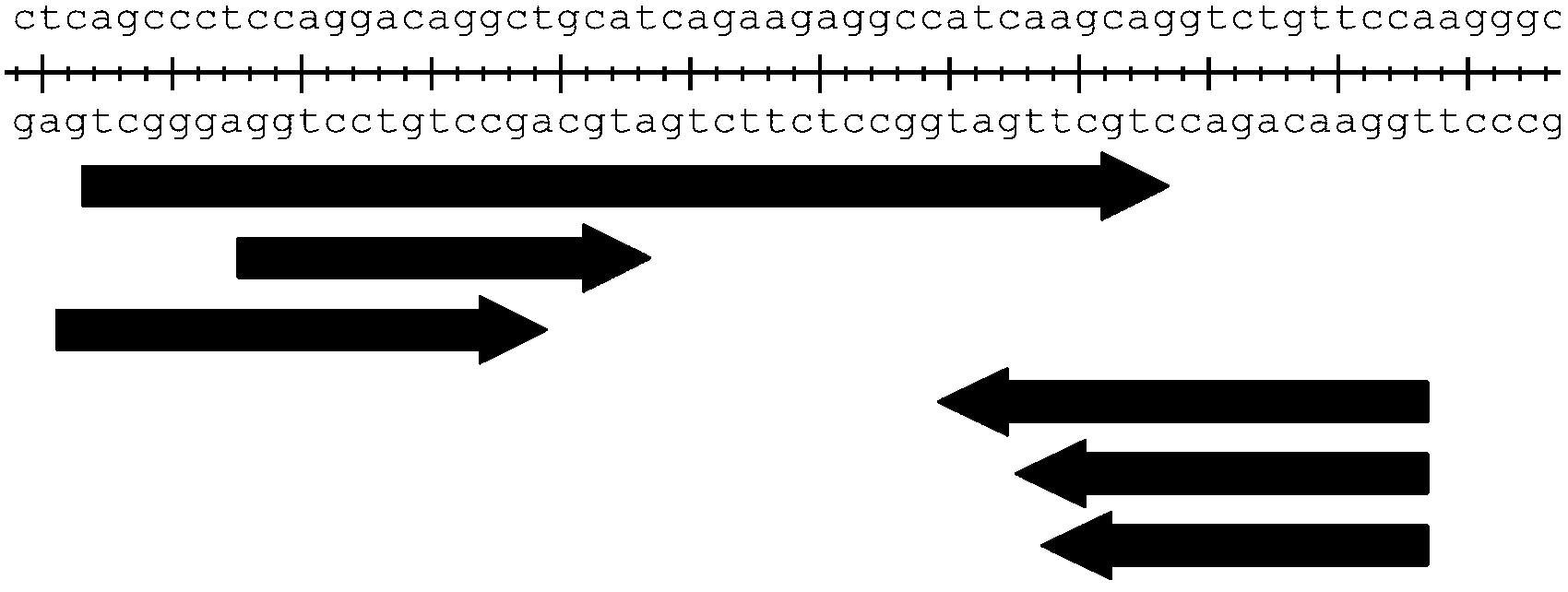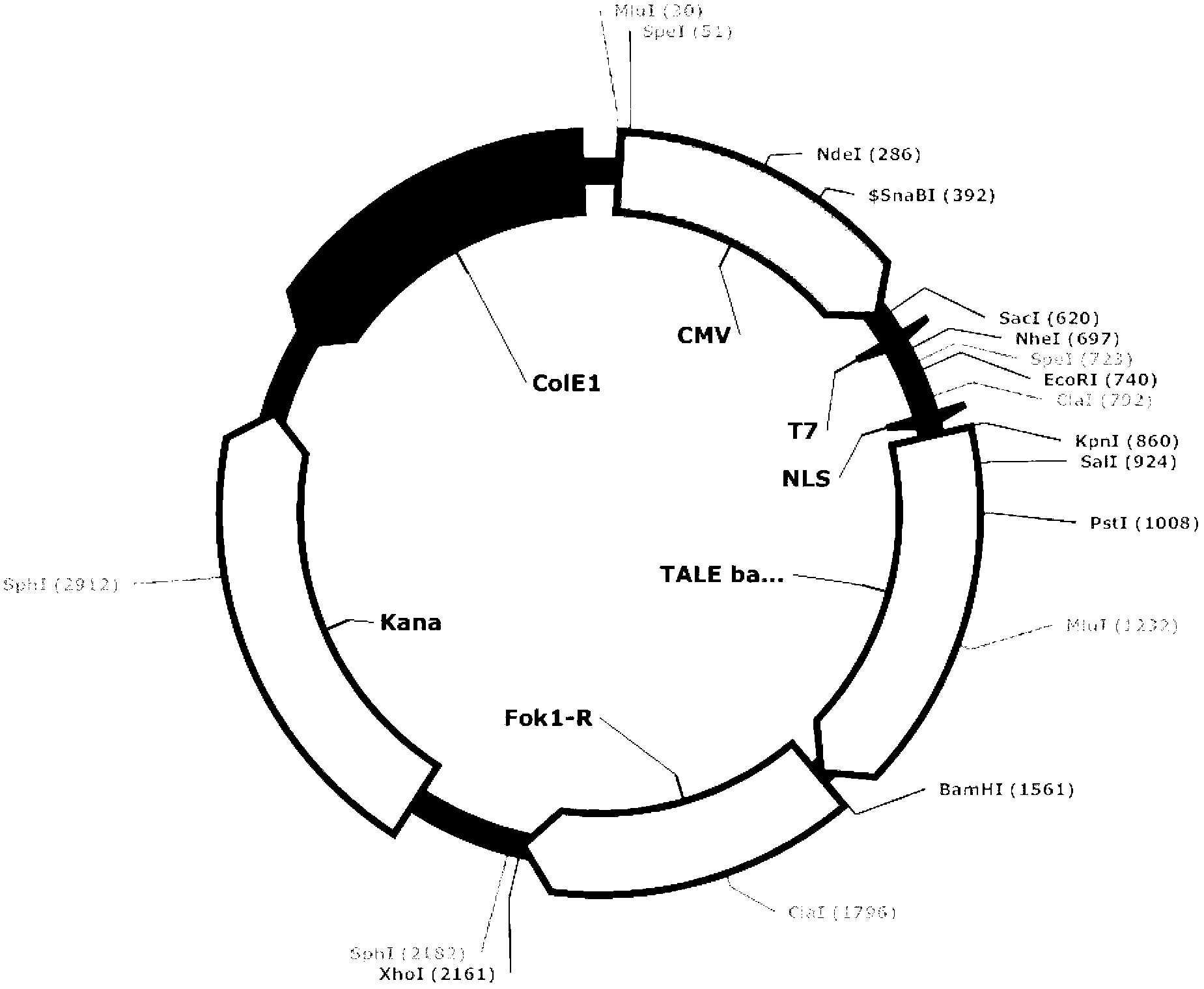Recombinant transcription activator like effector, transcription activator like effector nuclease, as well as coding gene and application thereof
A transcriptional activation and effector technology, applied in the field of genetic engineering, to achieve high targeting efficiency, high accuracy, and strong specificity
- Summary
- Abstract
- Description
- Claims
- Application Information
AI Technical Summary
Problems solved by technology
Method used
Image
Examples
Embodiment 1
[0039] Embodiment 1 Design of TALENs target sequence
[0040] 1. Download the human insulin genome sequence from NCBI (NC 000011.9)
[0041] 2. Design primers and PCR amplify the targeting site fragments on the genome, and sequence them. The PCR primers and sequencing primers are shown in Table 1;
[0042] Table 1
[0043]
[0044] 3. Design TALENs recognition sequence (target sequence):
[0045] According to the sequence obtained by sequencing, the recognition sequence of TALENs was determined according to the following principles:
[0046] (1) The 0th base is T (the base before the first in the recognition sequence is the 0th)
[0047] (2) The last base is T
[0048] (3) The length of the recognition sequence is between 13-19
[0049] (4) The length of the spacer sequence (Spacer) between the two recognition sequences is controlled between 13-21 (12 is also possible, but the efficiency may be lower)
[0050] The position of the designed target sequence is as follow...
Embodiment 2
[0054] Example 2 Connection between TALENs recognition modules and construction of recombinant vector
[0055] 1. Acquisition of TALENs identification module (modular)
[0056] (1) Synthesize four recognition modules NI, NG, HD, and NK that recognize bases A, T, C, and G respectively. The sequences are shown in Table 3.
[0057] table 3
[0058]
[0059] (2) Ligate the four fragments into the pEASY-B vector (purchased from Beijing Quanshijin Company), the ligation method is as follows: ① Take 3 μl of PCR product; ② Add 1 μl of pEASY-B vector; ③ 25°C, 7min; ④ Transform DH5a sensory State cells, coated with kanamycin plate; ⑤Pick clones, extract plasmids in a small amount, digest, sequence, and finally obtain the recognition modules NI, NG, HD, and NK connected to the vector pEASY-B.
[0060] 2. Identify connections between modules
[0061] Connection strategy: Take the connection of 19 identification modules as an example to illustrate the connection strategy. Since the...
Embodiment 3
[0105] Example 3 Transfection of plasmids into human 293T cells
[0106] 1. Add 100 μl Matrigel to each well of a 6-well plate, shake it back and forth to make it cover the bottom of the entire well, and place it in 5% CO 2 30min in the incubator.
[0107] 2. Aspirate the culture medium in the T25 bottle of cultured IPS cells, suck the PBS once, add 1mL 0.25% trypsin, shake back and forth to make it evenly cover the bottom of the bottle, and place in 5% CO 2 5min in the incubator.
[0108] 3. After digestion, add 1ml 10% DMEM to neutralize the trypsin, transfer the digested cells to a 15ml centrifuge tube, count the cells, and centrifuge at 1200rpm for 5min.
[0109] 4. Resuspend the cells with an appropriate amount of 10% DMEM, take 2 million 293T cells and place them in a 6-well plate that has been covered with Matrigel, and add 2ml of fresh 10% DMEM.
[0110] 5. Passage and transfect at the same time.
[0111] 6. Transfect cells with the constructed insulin-TALEN-L1, in...
PUM
 Login to View More
Login to View More Abstract
Description
Claims
Application Information
 Login to View More
Login to View More - R&D
- Intellectual Property
- Life Sciences
- Materials
- Tech Scout
- Unparalleled Data Quality
- Higher Quality Content
- 60% Fewer Hallucinations
Browse by: Latest US Patents, China's latest patents, Technical Efficacy Thesaurus, Application Domain, Technology Topic, Popular Technical Reports.
© 2025 PatSnap. All rights reserved.Legal|Privacy policy|Modern Slavery Act Transparency Statement|Sitemap|About US| Contact US: help@patsnap.com



